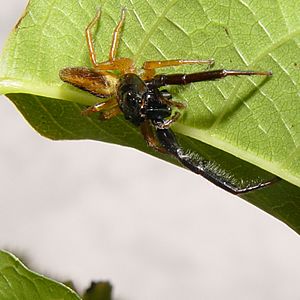Black-headed jumping spider facts for kids
Quick facts for kids Black-headed jumping spider |
|
|---|---|
 |
|
| Scientific classification | |
| Genus: |
Trite
|
| Species: |
planiceps
|
| Synonyms | |
|
Salticus minax |
|
Trite planiceps, also called the black-headed jumping spider, is a common type of jumping spider. It lives only in New Zealand. There are about 150 kinds of jumping spiders in New Zealand, and this is one of them.
Contents
About the Black-Headed Jumping Spider
How it Got its Name
This spider was first described in 1873. Back then, it was called Salticus minax. Scientists found it in places like Riccarton Bush and Governors Bay in New Zealand.
Later, in 1899, a scientist named Eugene Simon gave it its current name, Trite planiceps. In 2011, scientists used DNA to learn more about this spider and confirmed its name.
What it Looks Like
Both male and female black-headed jumping spiders are usually between 6 and 13.5 millimeters long. That's about the size of a small button.
Their head and chest area, called the cephalothorax, is shiny black. Their first pair of legs is also jet black. The body part behind their head, called the abdomen, is golden brown. It has a yellow stripe down the middle and sometimes looks a bit green.
Male spiders have longer front legs. They also have a line of dark hairs above their eyes. Their mouthparts, called chelicerae, are stronger than the females'.
Spider Behavior
How They Hunt
Most jumping spiders use their amazing eyesight to hunt. But Trite planiceps can catch prey even in the dark! They probably feel vibrations to find their food.
Unlike many other jumping spiders, they do not build web shelters at night. These spiders live in lower areas where winters can be cool and cloudy. They often hide inside the rolled-up leaves of plants like New Zealand flax (Phormium tenax). These leaves are usually long and wide, giving them a good hiding spot.
Courtship and Mating
When these spiders are ready to mate, they change how they act. If they are out in the open, they use their vision to find a partner. But inside a rolled-up leaf, they use vibrations to communicate.
If a male finds a young female who is almost ready to become an adult, he might live with her for about ten days. Then, they will mate inside the leaf. After mating, they stay in touch for a while, using touch to communicate. When a male or female spider enters a rolled-up leaf, they tap the leaf surface with their front legs. They also vibrate their abdomen.
Building Nests
Younger spiders build flat, tube-shaped silk cocoons inside rolled-up leaves. These cocoons have an opening at each end.
Adult female spiders build a silk platform that is much bigger than themselves. On this platform, they lay up to seven groups of eggs. Each group can have 8 to 40 eggs. Each group of eggs is wrapped in its own silk casing. Male spiders usually do not build nests.
Scientists have also seen males have special "duels" with each other.
Interactions with People
Black-headed jumping spiders are usually very calm. Because of this, bites from them are very rare. People can often hold them without getting bitten.
A Trite planiceps spider will only bite if it feels it needs to defend itself as a last choice. One story tells of a person who was bitten when they rolled over in bed and didn't know a spider was in their shirt. The bite felt like a sting on their shoulder. It left two small marks. After a few hours, the skin around the bite turned red. The swelling and soreness went away quickly, and the redness faded after about three days.
Images for kids
See also
 In Spanish: Trite planiceps para niños
In Spanish: Trite planiceps para niños


